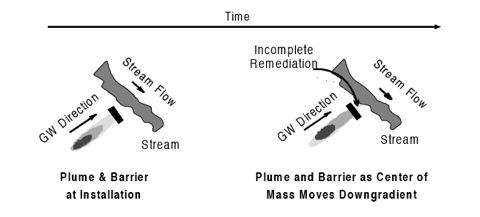
Lab Studies and Site Characterization for Permeable Reactive Barrier Walls
Contaminant Characterization
Information on contaminant concentrations is necessary for any remedial operation, whether pump and treat or in situ technologies are used, since the remediation technique must be effective up to the maximum concentrations that will be encountered. This is especially important for reactive barriers because, once emplaced, it is difficult to change the thickness of the reactive zone. The barrier must also be designed to eliminate the possibility that portions of the plume could flow around the barrier in any direction. This requires a complete understanding of the five-dimensional extent of the plume, the width, depth, length, concentrations within these spatial dimensions, and how these can be expected to change over the fifth dimension, the lifetime of the reactive wall.
Since permeable reactive barriers are generally placed downgradient of the plume center-of-mass, it is important that the barrier be designed to accommodate the higher upgradient concentrations, should they arrive at the barrier unattenuated. This requires sufficient contaminant characterization to accurately determine this high concentration zone. It is also clearly desirable to know whether this zone is moving downgradient over time or whether a steady-state has been achieved that could suggest natural attenuation is occurring. If steady-state boundaries have been achieved, the barrier could be designed to transect and attenuate only the lower downgradient concentration(s) for the protection of nearby receptors or to eliminate migration beyond site boundaries. The figure below illustrates the potential result if a reactive barrier is not designed to fully handle the contaminant concentrations that reach it over time. In this depiction, steady-state boundaries have not been achieved by natural attenuation processes, the plume center-of-mass has moved downgradient, and higher concentrations are impacting the barrier. Since the barrier was designed only for lower contaminant concentrations, incomplete remediation is now occurring.








